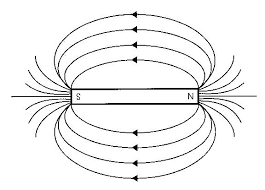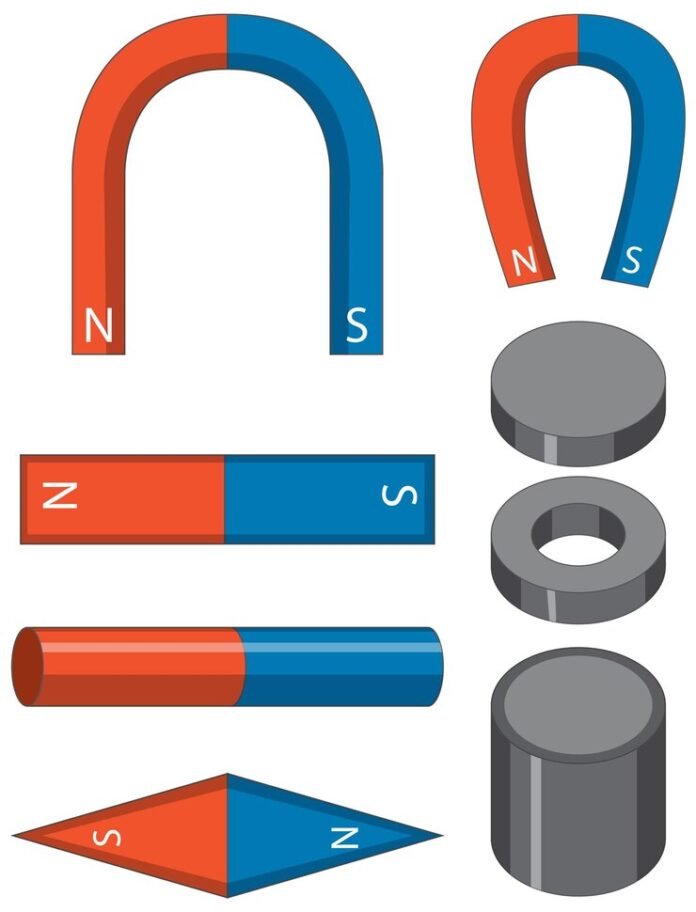All of us were fascinated by the characteristics of a bar magnet as children. When orientated in a specific way, it draws small iron scraps and nails and repels another magnet. We will learn specifically about bar magnets, their characteristics, and other relevant issues in this post. Let’s have a look.
Magnet
An object that can generate a magnetic field, attract unlike poles, and repel like poles is referred to as a magnet.
There are few properties of the magnet and some of them are mentioned below:
- We can see that when a magnet is covered in iron filings, the iron filings stick to the end of the magnet because there is the strongest attraction. These points are referred to as the magnets’ poles.
- There are always two magnetic poles.
- Anytime a magnet is suspended unrestrained in the air, it always faces north and south. The North Pole is the pole that points in the direction of the geographic north, and the South Pole is the pole that points in the direction of the geographic south.
- Although unlike poles attract, like poles repel.
- When the distance between the two magnets is smaller, the magnetic force between them is larger.
Classification of Magnets
Based on how they become magnetized, how long they can stay magnetized for, and their magnetic field, magnets are divided into two groups: natural and manufactured magnets. Natural magnets are far weaker than man made magnets and are found in nature.
- Natural magnets: Magnetic fields of natural magnets are weak and they are found in nature. A typical illustration of a natural magnet is a lodestone.
- Artificial magnets: These magnets can be created artificially and have a more powerful magnetic field. They can also be molded in any way needed. A bar magnet is an artificial magnet that has been given the shape of a bar.
Bar Magnet
A bar magnet is a rectangular section of an object that exhibits persistent magnetic qualities. It can be constructed of steel, iron, or any other ferromagnetic material. When suspended freely, the magnet’s two poles i.e., a north pole and a south pole, align themselves such that the northern pole faces the magnetic north pole of the earth.
Types of Bar Magnet
Bar magnets come in two varieties:
- Cylindrical Bar Magnets : A cylindrical rod, also referred to as a rod magnet, has a thickness that is equal to or greater than its diameter, enabling it to have a high magnetic field. These bar magnets are used in research, experimentation, and education.
- Rectangular Bar Magnets: Rectangular bar magnets are used in the engineering and industrial sectors because they have a stronger magnetic field than other magnets.
Properties
Bar magnets are having certain properties and some of the properties of bar magnets are enlisted below:
- At both ends, it has a north pole and a south pole. No matter how many pieces you break a bar magnet into, even if you split it from the middle, both parts will still have a north pole and a south pole.
- The poles of it have the strongest magnetic force.
- This magnet will not come to rest until the poles are lined up in a north-south position if it is hanging freely in the air with a thread. This characteristic is used by a mariner’s compass to identify direction.
- When two bar magnets are put close to one another, their opposing poles repel one another and their similar poles attract.
- All ferromagnetic substances, such as iron, nickel, and cobalt, are drawn to a bar magnet.
Lines of Magnetic Field Around a Bar Magnet
Let’s use the next exercise to comprehend the idea of magnetic field lines. Let’s place a bar magnet in the middle of a piece of paper with iron filings on it. The fillings appear to arrange themselves as indicated in the figure below when we tap the paper.

- The term “magnetic field lines” refers to hypothetical lines that might be drawn along any magnetic substance’s magnetic field. The magnetic field lines of a magnet form continuous closed loops and have specific characteristics.
- Any point’s tangent to the field line indicates the direction of the net magnetic field there.
- The magnitude of the magnetic field increases with the number of field lines crossing in a given area.
- Magnetic field lines don’t cross each other.
Uses of Bar Magnet
In laboratories, bar magnets are employed as stirrers for magnetic studies.
- They are used in medical operations as well.
- Magnets are used in electronic gadgets including telephones, radios, and televisions.
- Bar magnets are used in many industries to gather loose metals and maintain the magnetic properties of other magnets.
Recommended Articles:
What is Balanced and Unbalanced Force?
Balloon Experiments in Physics
Band Theory Of Solids: Definition, levels, Structures, and Applications
Understanding the Crucial Role Banking Of Roads for Safer Highways
Bar Magnet: Uses, Similarities, Behavior and Derivation
A bar magnet is a rectangular section of an object that exhibits persistent magnetic qualities. It can be constructed of steel, iron, or any other ferromagnetic material. The properties are mentioned below: The magnetic field lines of a magnet form continuous closed loops and have specific characteristics. The two uses of bar magnets are mentioned below: They are used in medical operations as well. Bar Magnet FAQs
Define bar magnet
Enlist any two properties of magnetic field lines produced by bar magnets.
Any point's tangent to the field line indicates the direction of the net magnetic field there.Mention any two uses of bar magnets.
Magnets are used in electronic gadgets including telephones, radios, and televisions.
